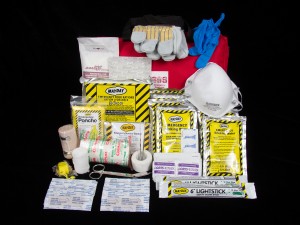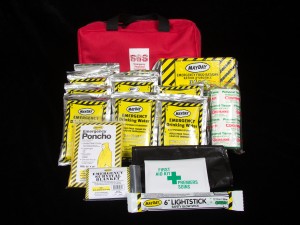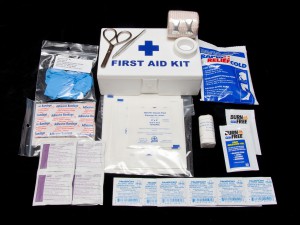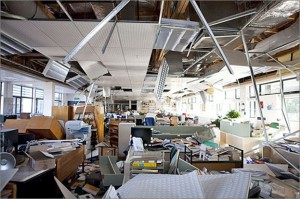Blog

Earthquake. Natural Disaster. Hurricane. Our newspaper headlines have been talking non-stop about these events, while the kids were getting settled back into school. Now your PAC needs to do some fundraising. But your tired of selling the same old thing to your family, neighbors and friends. Does anyone really need more chocolates, flowers and wrapping paper? Okay, we all need more chocolate! Launch a fundraiser that provides your community an opportunity to get prepared while raising those important dollars at the same time. By selling 72 hour Emergency Preparedness Kits, you provide the tools necessary for families to survive ANY emergency and/or earthquake and your PAC can earn up 10% per kit sold for your PAC.
On October 19th at 10:19am, over 500,000 will join with ShakeOutBC and practice DROP, COVER & HOLD. Register your school and join in to practice being safe during an earthquake https://www.shakeoutbc.ca/
PROTECT your loved ones. RAISE money for your school.
Call 604.277.5855 to get started now
SOS-Fundraiser-Poster-2017
Blog

72hr kit for car
When we think of emergency preparedness it is human nature to think on a grand scale – of an earthquake, major flood and/or fire. Although it may be unlikely to be faced with one of these major disasters, there is no doubt that you will be faced with personal emergencies in your lifetime. Major traffic jam due to accident, rain, snow or wind;, power outage, bridge closure or snow storm. Carrying an emergency and/or emergency preparedness kit in your vehicle in case of earthquake will help you in ANY emergency. If you do not want to make something on your own – go to www.sostech.ca and purchase SQ6009 or SQ6010 (images shown) – these are perfect sized kits for the car.
We have created a list of items that you should consider in your kit – we have also rated the importance of each item.
M – MUST have – must have in order to survive
R – RECOMMEND – not required for survival but useful in an emergency
N – NICE to have – not necessary for survival but will make the experience more tolerable
M Water; 2 litres per person per day
M Food Bars; while granola bars and energy bars can be used they are thirst provoking. Try our Coast Guard approved 3600 calorie meal replacement bars
M Running shoes or walking shoes; always keep an extra pair in the car. You may have to walk home or long distances
M Hat; to serve as sun block or cover in the rain
M Gloves; for warmth or to move debris out of the way
R Blanket;
R Emergency (foil) Blanket; small and compact this can be used for shelter and warmth
N Change of clothes;
M First Aid Kit;
M City Map; If you are on foot or a disaster has changed the landscape a good map will help you find your way around
M Paper & Pen;
M Flashlight;
M Toilet paper or kleenex
M Whistle; to alert for help if required
R Duct Tape
R Swiss Army Knife
R Variety of hand tools; think about carrying screw driver, folding shovel & hammer
R Money; $20 in change can come in handy
N AM/FM radio; to keep informed
N Rope; useful for securing shelter
N Garbage Bags; provides protection from rain and can be used for emergency shelter

72hr EP Kit for car
Blog
Although we originally posted this blog in 2014, we thought it was prudent to re-post in light of the earthquake near Christmas 2015.
Each year it seems we all rotate the same resolutions in order to achieve a longer life: eat healthier, exercise more or quit a bad habit. All of these changes are controllable throughout the whole year, but what about unexpected events that can threaten your life? Unfortunately many people don’t think about emergency preparedness until they hear about a disaster that has happened somewhere else.
What if the disaster hits closer to home? Are you and your family prepared? Do you have an emergency plan?
Instead of recycling those usual and tired resolutions, this year make a resolution for you and your family to be safe. To help you out we at SOS Emergency Response Technologies have come up with 3 quick and easy steps to achieve this goal, so you can sit back and boast to your friends that you accomplished your resolutions for the year.
Step one – Check the batteries in your smoke detector.
Step two – Check your first aid kits. Take a look and see if any products are expired and need to be replaced. If you don’t have a first aid kit we recommend our General Purpose First Aid Kit FK1021 $14.95.

Step three – Check your emergency preparedness kit and update your emergency plan/contacts if needed. If you use bottles of water they have to be replaced yearly. Emergency Food Ration Bars and Emergency Sterile Water Packets last longer (5 years). Double check your contact lists to make sure it is up to date with current information and remind your family about the emergency plan you put in place. If you don’t have an emergency plan there are many sources on the internet. These days we find ourselves working and running errands at all hours of the day so the chances of your family being split up when a disaster hits are larger. Make sure you set a meeting point.
If you don’t have an emergency preparedness kit SOS Emergency Response Technologies has a variety of options to choose from. We have kits for 1, 2 and 4 person families and have economical versions as well.

That’s all there is to it! Although, there are a few extra steps you could take to make sure those around you are safe as well. Ask the human resources team if your workplace has an emergency plan as well as emergency kits. If you are on the safety committee make a point to bring it up at the next meeting and set up an emergency plan for your work place. SOS Emergency Response Technologies can also provide emergency preparedness kits and products for your workplace.

Blog
Jackie Kloosterboer has been teaching people how to prepare for earthquakes for close to 2 decades. She is the author of My Earthquake Preparedness Guide – Simple Steps to get You, Your Family and Pets Prepared. Follow Jackie on Twitter @Surviving_it to receive Earthquake Preparedness tips to help develop your Family’s Earthquake Plan.
| Nepal – Could we be next?The devastating Nepal earthquake claimed the lives of so many innocent men, women and children, injured thousands, devastated people’s livelihoods and then less than a month later another earthquake – absolutely unbelievable! What terrifies me is – like Nepal we too are overdue for an earthquake and so few of us are prepared. I can only imagine what it would be like on the West Coast in the aftermath of 2 major earthquakes. We need to look at Nepal as yet another wakeup call and start taking action to get ourselves, our families and pets prepared – we could be next! Look at your own family, how would an earthquake impact them? What if you are not together when it strikes – could they survive without you? What plans do you have to connect after an earthquake? What supplies have you got stored so you can better survive-it? If you are like most people, you have a few supplies tucked away in the back of the hall closet – but do you have enough to sustain you, your family and pets for a minimum of 3 days – a week is even better! The following 3 simple steps is a great place to start to better protect you, your family and pets in an earthquake:
Create your Family Meeting Places Family Meeting Places are pre-identified locations where your family will meet when unable to connect using regular methods of communication. Hopefully we are home together when facing an earthquake, but that may not be the case, we could be at work, they could be at soccer practice – we just don’t know. That is why you need to identify Family Meeting Places so you will have options to connect. The more options you have the better your chances of connecting with your family. Your first Family Meeting Place should be outside your home – if you need to evacuate quickly such as for a house fire this is where you and your family will meet. Across the street is good. If you evacuate through different doors you could be scattered and not know the safety of your family because you can’t locate them. This Family Meeting Place will help you connect much faster and you will know everyone is safe much quicker. Develop a second Family Meeting Places within walking distance of your home. If you must evacuate your home or you are not able to return home your family can meet there. A friend or family member who lives within walking distance works well. Once you have connected with your family you can then determine your next move. For those of you who work close together – identify a Family Meeting Place close to your work. If you cross bridges to get home you may find them closed after an earthquake. If you have a Family Meeting Place near your work you can meet your family who is in the same area and then determine if best to make your way home or stay in your current location. Look at your daily lives and identify if there are other Family Meeting Places you need to identify to help connect your family.
Designate Your Family’s Out of Area Contact When an earthquake strikes there are so many unknowns – will our internet be down, will we be able to text – will our cell phones work – until the earthquake happens we don’t know the answer. What we do know is – the more options you have available to connect with your family the better your chances will be of making that connection. In addition to your Family Meeting Places, an Out of Area contact provides another way for you to connect with your family. We know our home phones and cell phones will likely not be working after a significant earthquake, but often long distance will still work.
Simply identify someone who lives out of the province (preferably east of the Rockies) to be your family’s Out of Area Contact. When faced with an earthquake and cell phones and local phones lines are not working, you and your family members will know to call your Out of Area contact to provide your status and get updates on family members who have already called in.
A word of caution – we all put our contact numbers in our cell phones – but if power is out and you can’t charge your phone you won’t have access to your Out of Area contact number. Make sure you carry your Out of Area’s contact number in your wallet.
Know what to do when the earth starts moving Drop, Cover and Hold On – this must become second nature to all of us. When the earth starts moving we must immediately Drop, Cover and Hold On underneath a heavy table or desk or against an interior wall so we are better protected from falling and shooting objects. Once the shaking stops – slowly count to 60 then cautiously get out of your safe spot and check your surroundings. Check on family members and then identify what your next move will be. The above 3 steps are not difficult for you and your family to do and if this is all you do, you will better survive the earthquake. But don’t stop here – keep going and get those emergency kits and supplies your family will need and make your home and office safe so when the earth starts moving – you, your family and pets will be better protected. Once the earthquake hits it will be too late. You won’t be able to run out and get what you need. The time to do it is now. Remember – your family is counting on you! |
|
Blog
When planning for an emergency the rule of thumb is to plan for the “worst case scenario.” Out here on the west coast we always hear all this earthquake talk…the big one is coming…expect the unexpected.
Much of the concern centers on school safety, preparing a household kit, there is less discussion on how your business if going to be affected. The rule of thumb is for households to be able to manage without help for 72 hours after an emergency. Whether it be flood, earthquake or any other natural disaster. However, businesses really need to be prepared to survive for a lot longer than that. Businesses require more resources than you would expect to remain operational. We have to assume airports will be closed, bridges will be inaccessible and infrastructure will be compromised.
According to the Toronto based Institute for Catastrophic Loss Reduction, “A quarter of businesses that close because of natural disaster never reopen.” It also says businesses with fewer than 10 employees are “especially vulnerable.”
FACT: Vancouver is at risk for a major earthquake.
According to Barbara Yaffe, a reporter for the Vancouver Sun, “Companies in this city that prepare for a Big One will have a much better chance of reopening and surviving financially.”
We at SOS understand that employers might have a hard time investing time and money in disaster planning when they are concerned about meeting the next payroll – but making the decision to be prepared now will aid local business should a natural disaster occur. The loss of jobs, life and property is a reality if businesses do not take the time to invest and plan properly. With a 1/3 of our time spent at work many of us could find ourselves at work when an earthquake hits.
Does your office have a plan? supplies?








